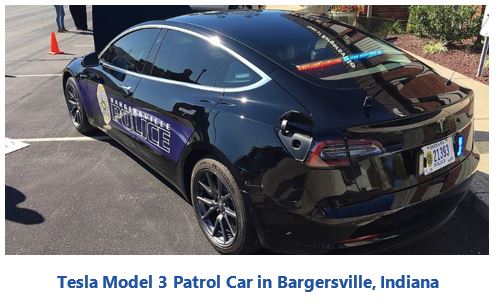

Transportation is one of the fastest changing sectors in the global economy. Connected and autonomous vehicles, shared mobility concepts, and the shift to electric vehicles (together referred to as CASE) are some of the most exciting avenues.
Within CASE, the fastest transformation under way is vehicle electrification. Private drivers have been upgrading to electric mobility by the millions, yet some of the most exciting and impactful action is happening on the fleet/commercial side. Delivery vans and trucks, public transit, ride-hail, and even construction fleets are moving in this direction, drawn by overwhelming benefits financial and otherwise. In this ARC Insight, we will explore the potential for electric police cruisers to help law enforcement agencies reduce costs, emissions, and better serve their communities. This report also discusses the experiences of a US police department that began electrifying its cruiser fleet in 2019.
Electric vehicles are cheaper to operate than those powered by fossil fuels.
To start with, electric powertrains have lower energy costs on a per-mile basis than internal combustion engines. They convert energy into motion more efficiently, with today’s battery electric vehicles (BEVs) attaining approximately three times the miles-per-gallon equivalent (MPGe) of their traditional fossil-fueled counterparts.
Beyond the lower energy costs, BEVs have fewer moving parts than internal combustion engine vehicles (ICEVs) and forgo liquid fuels entirely. Below is a list of part replacements/maintenance/issues that BEV owners do not need to worry about:
An EV owner does need to be mindful of their lithium-ion battery, as these lose charging capacity over time and may require replacement. Fortunately, data from drivers of Tesla and Chevy BEVs point to significant battery resilience.
BEVs are expected to last a long time thanks to their simplicity and lower number of moving parts. For this reason, an owner may find that when a battery does eventually wear out, it may make sense to replace it instead of buying a new vehicle. Furthermore, since grid/building operators are making use of Li-ion batteries to improve power quality and better integrate renewables, the residual value of a lower capacity BEV battery is expected to be far larger than the scrap value of an entire ICEV.
Like most fleet operators, police departments are drawn by the cost savings that vehicle electrification brings. Saving money is always desirable, but events in 2020 have introduced new pressures on police departments and the public sector as a whole. First, the global COVID-19 pandemic has strained state and local budgets with a combination of lower tax revenues and higher expenditures on public health and social services. Brookings Institute estimates state and local governments are losing $155 billion in tax revenue in 2020, and could lose even more in 2021.
In addition, a wave of social unrest focused on law enforcement has soured relations between police departments and their communities. Many of the protesters are demanding that governments “defund the police.” Though such extreme measures are unlikely in most places, in response some city councils are already funneling parts of police budgets to other government services in the coming cycle.
Police departments would clearly benefit from finding new ways to save money while creating opportunities for positive engagement with the communities they serve.
Electrification fits this need nicely as the switch to electric vehicles can dramatically reduce a police department’s carbon footprint while saving taxpayer money. With awareness of sustainability issues growing rapidly in society, decarbonization will help earn much needed positive PR, while helping alleviate budgetary pressures.
Furthermore, the operation of most police vehicles involves plenty of start and stop driving and engine idling, while also occasionally requiring vital high performance. This is a perfect use case for electric powertrains, which utilize regenerative braking, use no energy while standing still, and provide superior road performance.
Bargersville, Indiana is a small suburb of Indianapolis. In 2018, the community was rapidly expanding and in need of new officers to serve the growing population. Since property tax revenues tend to lag behind growth, the town’s police chief set out looking for 
According to the chief, “I was looking through the budget and one of the biggest line items we had…were fuel and maintenance. If I didn’t have to pay for those, that’s two more officers.”
The town decided to purchase Tesla Model 3s to replace a few retiring Dodge Chargers.
In the first year with the Teslas, the department recorded cost savings of more than $6,000 in fuel and maintenance per vehicle compared to the Dodge Chargers in the fleet, with officers driving around 22,000 miles annually. This, despite abnormally low gas prices during the period. This one-year cost savings was slightly greater than the price premium paid up front for the EVs and associated charging equipment.
ARC Advisory Group clients can view the complete report at ARC Client Portal
If you would like to buy this report or obtain information on how to become a client, please contact us
Keywords: Electric Vehicles, EVs, Public Agency Fleets, Law Enforcement, Police Cars, ARC Advisory Group.

